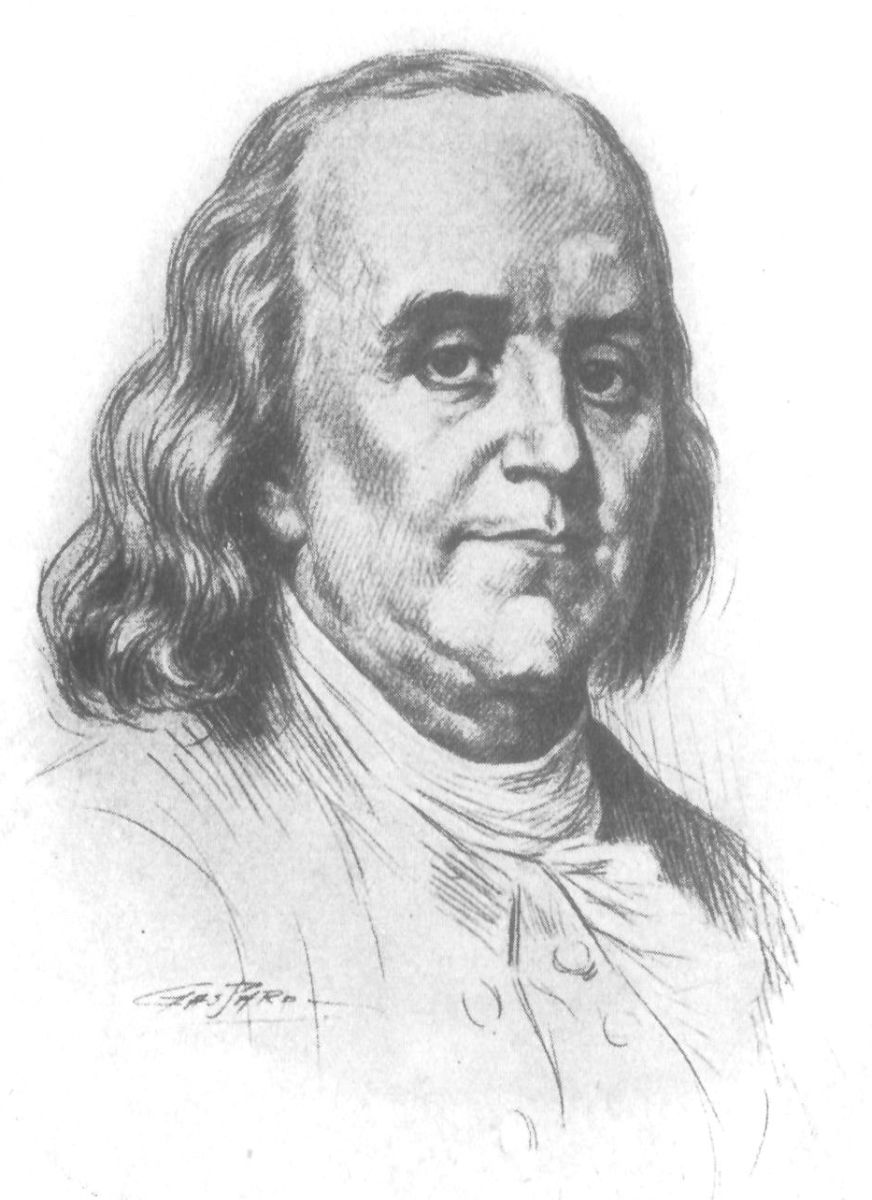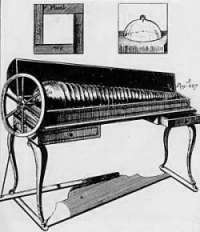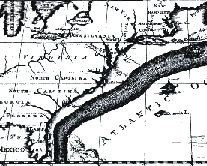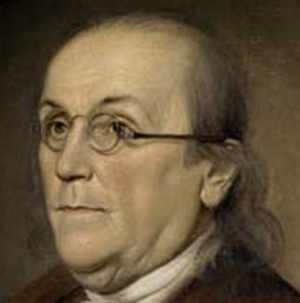Benjamin Franklin

Benjamin Franklin was born on January 17, 1706 in Boston, Massachusetts. His accomplishments as a scientist, publisher and statesman are particularly remarkable when considered in the context of colonial North America, which lacked the cultural and commercial institutions to nourish original ideas. He dedicated himself to the improvement of everyday life for the widest number of people and, in so doing, made an indelible mark on the emerging nation.
Leather Apron Club
Benjamin Franklin initially gained acclaim through his organization of the Junto (or the Leather Apron Club), a small group of young men who engaged in business and debated morality, politics, and philosophy. Through his work with the club, Ben Franklin is credited with initiating a paid city watch, volunteer fire department, subscription library (Library Company of Philadelphia), and the American Philosophical Society, which promoted scientific and intellectual dialogue and, to this day, is one of the nation's premiere scholarly associations.
Scientist
Benjamin Franklin's inventions include
bifocal glasses and the iron furnace stove, a small contraption with a sliding door which burns wood on a grate, thus allowing people to cook food and heat their homes at the same time.
Mid-eighteenth century scientists and inventors considered electricity to be Franklin's most remarkable area of investigation and discovery. In his famous experiment using a key and a kite during a thunderstorm, Franklin (working with his son) tested his hypothesis that lightning bolts are actually powerful electrical currents. This work led to the invention of the lightning rod which had the dramatic effect of preventing structures from igniting and burning as the result of being struck by lightning.
Publisher
Although Benjamin Franklin had little formal education, he was an avid reader and writer. At twelve he was apprenticed to his brother James, a printer, who published a weekly magazine called The Spectator. At seventeen Franklin moved to Philadelphia and quickly opened his own print shop and started publishing.Benjamin Franklin's publications reflected his democratic spirit and so were popular in format and content. Poor Richard's Almanac consisted of stories about a fictional "Poor Richard" whose trials and tribulations provided an ideal context in which Franklin could advise readers on politics, philosophy, and how
to get ahead in the world.
Franklin's Pennsylvania Gazette provided information about politics to the people. Ben Franklin used political cartoons to illustrate news stories and to heighten reader appeal. The May 9, 1754 issue included Join, or Die, which is widely considered the first American political cartoon. Devised by Franklin, the cartoon reflected concern about increasing French pressure along the western frontier of the colonies.
Statesmen
To protest the Stamp Act provisions, which required newspapers be printed on imported, stamped paper, Franklin had the November 7, 1765 edition of the Pennsylvania Gaze tte printed without date, number, masthead, or imprint. In doing so, he highlighted the impact of royal policies on colonial freedom and exe rted colonists' autonomy.Recognizing the tyranny and corruption of rule by few, Benjamin Franklin and his contemporaries George Washington and Thomas Jefferson rejected the European model of aristocratic rule and crafted a system based on representational democracy. Franklin was a member of the Continental Congress which crafted the Articles of Confederation and he helped draft the Declaration of Independence and the Constitution. These documents elevated the importance of the individual in the political process, promising the state's protection of citizens' natural, inalienable rights.
Ben Franklin also played a vital diplomatic role during the American Revolution and the early national period. In 1776, the Continental Congress sent Franklin and several others to secure a formal alliance with France, which deeply resented the loss of territory to the British during the French and Indian War. American victory over the British in the Battle of Saratoga convinced the French that the Americans were committed to independence and would be worthy partners in a formal alliance. During the war, France contributed an estimated twelve thousand soldiers and thirty-two thousand sailors to the American war effort.
In the last decade of his life, Benjamin Franklin served as a member of the Constitutional Convention and was elected president of the Pennsylvania Society for Promoting the Abolition of Slavery. Historians have called him the quintessential American because of his creative pragmatism, scientific innovation, and democratic spirit.
List of Inventions
Swim fins, bifocals, a glass armonica, watertight bulkheads for ships, the lightning rod, an odometer, and the wood stove (called the Franklin stove).
Benjamin Franklin - Armonica
 "Of all my inventions, the glass armonica has given me the greatest
personal satisfaction."
"Of all my inventions, the glass armonica has given me the greatest
personal satisfaction."
Benjamin Franklin was inspired to create his own version of the armonica after listening to a concert of Handel's Water Music which was played on tuned wine glasses.
Benjamin Franklin's armonica, created in 1761, was smaller than the originals and did not require water tuning. Benjamin Franklin's design used glasses that were blown in the proper size and thickness which created the proper pitch without having to be filled with water. The glasses were nested in each other which made the instrument more compact and playable. The glasses were mounted on a spindle which was turned by a foot treadle.
His armonica won popularity in England and on the Continent. Beethoven and Mozart composed music for it. Benjamin Franklin, an avid musician, kept the armonica in the blue room on the third floor of his house. He enjoyed playing armonica/ harpsicord duets with his daughter Sally and bringing the armonica to get togethers at his friends' homes.
Benjamin Franklin - Franklin Stove
Fireplaces were the main source of heat for homes in the 18th century. Most fireplaces of the day were very inefficient. They produced a lot of smoke and most of the heat that was generated went right out the chimney. Sparks in the home were of great concern because they could cause a fire that would quickly destroy the homes, which were constructed mainly with wood.
Benjamin Franklin developed a new style of stove with a hoodlike enclosure in the front and an airbox in the rear. The new stove and reconfiguration of the flues allowed for a more efficient fire, one that used one quarter as much wood and generated twice as much heat. When offered a patent for the fireplace's design, Benjamin Franklin turned it down. He did not want to make a profit. He wanted all people to benefit from his invention.
Benjamin Franklin - Lightening Rod

In 1752, Benjamin Franklin conducted his famous kite flying experiments and proved that lightning is electricity. During the 1700s lightning was a major cause of fires. Many buildings caught on fire when struck by lightning and kept burning because they were built mainly of wood.
Benjamin Franklin wanted his experiment to be practical, so he developed the lightning rod. A tall rod is attached to the outside wall of the house. One end of the rod points up into the sky; the other end is connected to a cable, which stretches down the side of the house to the ground. The end of the cable is then buried at least ten feet underground. The rod attracts the lightning and sends the charge into the ground, which helps to decrease the amount of fires.
Benjamin Franklin - Bifocals
Benjamin Franklin - Map of Gulf Stream
 Ben Franklin always wondered why
sailing from America to Europe took less time than going the other
way. Finding the answer to this would help to speed travel, shipments
and mail deliveries across the ocean. Franklin was the first scientist
to study and map the Gulf Stream. He measured wind speeds and current
depth, speed and temperature. Ben Franklin described the Gulf Stream
as a river of warm water and mapped it as flowing north from the West
Indies, along the East Coast of North America and east across the
Atlantic Ocean to Europe.
Ben Franklin always wondered why
sailing from America to Europe took less time than going the other
way. Finding the answer to this would help to speed travel, shipments
and mail deliveries across the ocean. Franklin was the first scientist
to study and map the Gulf Stream. He measured wind speeds and current
depth, speed and temperature. Ben Franklin described the Gulf Stream
as a river of warm water and mapped it as flowing north from the West
Indies, along the East Coast of North America and east across the
Atlantic Ocean to Europe.
Benjamin Franklin - Daylight Savings Time
Ben Franklin believed that people should should use daylight productively. He was one of the greatest supporters of daylight savings time in summer.
Benjamin Franklin - Odometer
While serving as Postmaster General in 1775, Franklin decided to analyze the best routes for delivering the mail. He invented a simple odometer to help measure the mileage of the routes that he attached to his carriage
